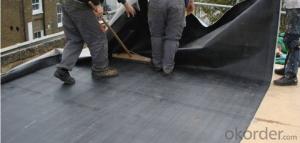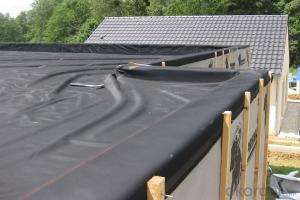EPDM Reinforced Waterproof Membrane with 2.0mm Thickness
- Loading Port:
- Shanghai
- Payment Terms:
- TT OR LC
- Min Order Qty:
- 50000 m²
- Supply Capability:
- 5000000 m²/month
OKorder Service Pledge
OKorder Financial Service
You Might Also Like
EPDM Reinforced Waterproof Membrane with 2.0mm Thickness
Description Of EPDM Reinforced Waterproof Membrane with 2.0mm Thickness:
1. Excellent physical and mechanical performance, high tearing resistance;good deformation adaptability, high puncture resistance;
2. High aging resistance, high UV resistance, anti-acid & alkali;
3. Excellent low & high temperature resistance, innocuous, long life span;
4. Perfect water proof performance, seepage and humidity resistance.
Main Features of EPDM Reinforced Waterproof Membrane with 2.0mm Thickness:
A.Polyester based SBS Modified Bitumen Waterproofing Membrane
a. Strong impermeability
b. High tensile strength, elongation, ability to adapt the grassroots shrinkage deformation and cracking
c. Puncture-resistant, broken resistant, tear-resistant
d. The corrosion resistance, resistance to mildew, weathering good
e. Construction convenient, hot-melt can be operated Four Seasons Construction, reliable joints
B. Fiberglass based SBS Modified Bitumen Waterproofing Membrane
a. High tensile strength, stability of a good size
b. High Temperature good performance
c. Damage resistance, corrosion resistance, resistance to mildew, weathering good performance
d. Good construction performance, reliable joints.
Specifications of EPDM Reinforced Waterproof Membrane with 2.0mm Thickness:
| Material | EPDM Rubber |
| Size | 1.2m (width)*20m (length) or customized, weldable type 2.05m or 4m width |
| Thick | 1.2mm, 1.5mm, 2.0mm |
| Type | Vulcanized & Weldable |
| Pattern | Non-reinforced (homogeneous) |
| Certificate | ISO9001/14001 |
Applications of EPDM Reinforced Waterproof Membrane with 2.0mm Thickness:
geomembrane used in groundsill of road, highway, railway and waterproof layer of swelling clay and wet collapsed loess.Geomembrane can be widely used in areas of garbage burying, waste disposal and underground construction projects.such as below:
- aquaculture ponds
- Ouchi root barrier membrane
- Floating baffles;
- Process wastewater
- Stormwater impoundments;
- Secondary containment;
- Spill containment
- Manure and biogas tanks and covers
- Potable water tanks and covers;
- Sludge Drying beds;
- Bioremediation covers & liners;
- Leachate ponds



IMages of EPDM Reinforced Waterproof Membrane with 2.0mm Thickness:




FAQ of EPDM Reinforced Waterproof Membrane with 2.0mm Thickness:
1. What are we supplying?
We are specialized in producing Colorful Asphalt Roof Shingle, SBS/APP modified bitumen waterproof membrane, Self adhesive bitumen waterproof membrane, PVC waterproofing membrane, EPDM rubber roofing membrane, Single Component Polyurethane Waterproof Coating, and Spray Polyurea Waterproof Coating
.
2. How Many years experience do we have?
We have been exported to more than 20 countries in the past 15 years.
3. How long do we usually reply your request?
We always reply our customer within 24 hours.
- Q: Can a waterproofing membrane be used in areas with high humidity?
- Yes, a waterproofing membrane can be used in areas with high humidity. In fact, high humidity can often contribute to the need for waterproofing as it can lead to moisture buildup and potential water damage. Waterproofing membranes are designed to create a barrier that prevents water from seeping through surfaces, such as walls or floors. They can effectively protect against moisture and water infiltration, which is particularly important in high humidity areas where the risk of water damage is greater. By applying a waterproofing membrane, you can significantly reduce the likelihood of mold, mildew, and other moisture-related issues in these environments.
- Q: Can a waterproofing membrane be used for a balcony?
- A balcony can indeed use a waterproofing membrane. Its purpose is to safeguard against water infiltration and shield surfaces from moisture-related harm. Since balconies are exposed to the elements and vulnerable to water damage, it is crucial to apply a waterproofing membrane in order to prolong their lifespan and maintain their structural soundness. By applying the membrane to the surface of the balcony, a barrier is created that effectively prevents water from seeping through cracks or joints. Consequently, this safeguards against water-related issues such as leaks, mold, and deterioration of structural components. It is of utmost importance to choose a high-quality waterproofing membrane that is specifically suitable for outdoor use and capable of withstanding exposure to UV rays, temperature fluctuations, and foot traffic. Consulting a professional contractor is recommended to ensure proper installation and to select the most appropriate waterproofing system tailored to the specific needs of your balcony.
- Q: Are there any specific installation requirements for waterproofing membranes?
- Yes, there are specific installation requirements for waterproofing membranes. These requirements may vary depending on the type of membrane being used, but common requirements include proper surface preparation, application of a primer if necessary, ensuring the membrane is correctly positioned and stretched, and using the appropriate adhesive or sealant for bonding. It is essential to follow the manufacturer's guidelines and recommendations to ensure proper installation and the effectiveness of the waterproofing membrane.
- Q: Can a waterproofing membrane be used for a swimming pool liner installation?
- Certainly! When it comes to installing a swimming pool liner, utilizing a waterproofing membrane is indeed a viable option. These membranes are meticulously crafted to establish a formidable shield against water infiltration, rendering them a superb selection for pool lining purposes. Typically composed of resilient substances like PVC or EPDM, these membranes possess remarkable resistance to both chemicals and UV rays. Consequently, they proficiently halt the permeation of water through the pool structure, shielding it from the detrimental effects induced by moisture. Moreover, the flexibility inherent in waterproofing membranes enables effortless tailoring to accommodate pools of diverse shapes and dimensions, ensuring a flawless and impervious installation.
- Q: Can a waterproofing membrane be used on concrete block surfaces?
- Yes, a waterproofing membrane can be used on concrete block surfaces. Waterproofing membranes are designed to provide a barrier against moisture and water penetration, and they are commonly used on concrete block surfaces to protect against water damage and leaks. These membranes are typically applied as a liquid or sheet material and adhere to the surface of the concrete blocks, creating a protective layer that prevents water from seeping through. The waterproofing membrane helps to extend the lifespan of the concrete blocks by reducing the risk of water damage, mold growth, and deterioration. It is important to choose a waterproofing membrane that is specifically designed for concrete block surfaces and follow the manufacturer's instructions for proper installation to ensure the best results.
- Q: Can a waterproofing membrane be installed by a homeowner or is professional installation necessary?
- A waterproofing membrane can technically be installed by a homeowner, but it is highly recommended to have professional installation for optimal results. Waterproofing membranes are designed to protect buildings from water damage and require proper installation techniques and expertise to ensure their effectiveness. Professional installers have the knowledge and experience to properly assess the needs of the specific project, select the appropriate type of membrane, and install it correctly. They understand the best methods for surface preparation, membrane application, and seam sealing to create a watertight barrier. Additionally, professional installers have access to specialized equipment and tools that may be necessary for the installation process. They can also provide warranties or guarantees for their work, providing homeowners with peace of mind and protection in case any issues arise in the future. While it may seem possible for a homeowner to attempt the installation themselves, any mistakes or improper installation techniques could result in water leaks, mold growth, or other costly damages. It is always better to invest in professional installation to ensure that the waterproofing membrane functions as intended and provides long-term protection for the building.
- Q: What kind of waterproofing membrane, waterproofing membrane is how to classify their respective advantages?
- TPO waterproofing membrane: strictly speaking TPO waterproofing membrane is EPDM (EPDM) and PVC combination, most of the performance are lower than EPDM.
- Q: Can a waterproofing membrane be used on plaster surfaces?
- Yes, a waterproofing membrane can be used on plaster surfaces. It provides a protective barrier that prevents water penetration and helps to enhance the durability and longevity of the plaster surface.
- Q: Can a waterproofing membrane be used on terraces or patios?
- Terraces and patios can benefit greatly from the application of a waterproofing membrane. To avoid water damage and leakage, it is highly recommended to use this protective layer in these areas. Given that terraces and patios are exposed to different weather conditions, such as rain and snow, moisture can easily seep into the underlying structure. To counteract this issue, a waterproofing membrane acts as a barrier, preventing water from infiltrating the surface and safeguarding the integrity of the terrace or patio. This solution not only extends the lifespan of the structure but also prevents costly repairs in the future. Moreover, the use of a waterproofing membrane contributes to the creation of a more comfortable and functional space, as it eliminates the risk of water accumulation and potential slip hazards. All in all, investing in a high-quality waterproofing membrane is a wise choice for those seeking to protect their terrace or patio from water damage.
- Q: Are waterproofing membranes suitable for stadium structures?
- Waterproofing membranes are well-suited for stadium structures. Stadiums are exposed to different weather conditions, such as rain, snow, and humidity, which can potentially harm the structure if proper waterproofing measures are not taken. By providing a protective layer that prevents water infiltration, waterproofing membranes safeguard the stadium from moisture-related problems like leaks, mold, and corrosion. Water accumulation on large roof areas and expansive seating areas is common in stadium structures, making waterproofing essential. Membranes can be applied on various surfaces, such as concrete, metal, and wood, offering a versatile and effective waterproofing solution for stadiums. Furthermore, waterproofing membranes offer durability and longevity, which is crucial for stadiums that experience heavy usage and constant exposure to the elements. They are designed to withstand thermal expansion and contraction, as well as UV radiation, ensuring long-term protection for the structure. Moreover, architects and engineers can customize waterproofing membranes to meet specific design requirements, seamlessly integrating them into the stadium's overall aesthetic. These membranes come in various colors, textures, and finishes, allowing them to blend with the surrounding materials and enhance the stadium's visual appeal. In conclusion, waterproofing membranes are a reliable and effective solution for protecting stadium structures from water damage. They provide durability, versatility, and customization options, making them suitable for any stadium construction or renovation project.
Send your message to us
EPDM Reinforced Waterproof Membrane with 2.0mm Thickness
- Loading Port:
- Shanghai
- Payment Terms:
- TT OR LC
- Min Order Qty:
- 50000 m²
- Supply Capability:
- 5000000 m²/month
OKorder Service Pledge
OKorder Financial Service
Similar products
Hot products
Hot Searches
Related keywords


































